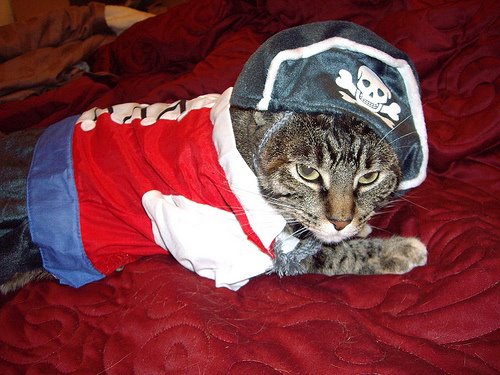And now, in honor of the feast of St. Patrick (coming up one week from today!), I'm sharing a tutorial with zillions of images so you can make your very own. All I ask is that if you use my tutorial to make things, you not sell them, and if you post my tutorial anywhere, please include a link back to this blog entry.
In the pictures below, I use *contrasting* thread so you can more easily follow along. When you make your own items, I recommend using thread that will blend in with the color of felt you are sewing.
If you need to see a larger version of a picture, just click on it and you will be taken to that photo at flickr.
Materials
- scissors
- thread
- polyfil
- felt in these colors, 1 sheet each:
ivory
camel (tan)
cardinal (darkish red)
orange
light green (sometimes sold as neon green or lime green)
Potatoes
Cut out three circles of ivory and three circles of camel/tan
Ivory felt: 3 1/4 inches across
Camel felt: 2 1/4 inches across
Hand sew around the edge of an ivory circle, but do not knot it off yet.
Instead, pull your thread to cinch the circle together into a little pouch.
Stuff the pouch firmly with polyfil, then sew across the opening several times, pulling tightly to close it securely.
Now you can knot and trim your thread.
This is your potato! Isn't it cute? But now we need to cover up the fugly opening we just stitched up. Get one of your camel circles and center it there.
Your potato will hold pins very nicely if you just push them straight in, like a pincushion. Pull the "skin" up around your potato and place pins evenly around the edge to keep it in place.
Now you can hand-sew the skin to the potato. Use small stitches, pull the thread evenly, and they should blend into the felt nicely.
Stitch all the way around, knot your thread, and hide the knot down in the skin.
Repeat this process with the rest of your circles to complete three potatoes.
Carrots
Fold felt in half. Draw two carrot outlines, about 3 inches long and 1 inch
wide, with a rounded end.
Stitch along each line, leaving the other ends of the carrots open.
Cut out the carrots and turn them right-side-out.
Stuff with polyfil. Hand sew around the top but do not knot it off yet.
Add additional polyfil if needed, then pull your thread to cinch the end
closed. Stitch across the opening several times, pulling tightly to keep the
end closed-off.
Now you can knot and trim your thread. Your carrots are done!
Cabbage
Cut out three rectangles of ivory felt and two of light green felt. Mine
are about 2 inches by 4 inches. Keep in mind we will be bunching them up,
so don't make them too short.
Hand sew lengthwise down the middle of one of the ivory rectangles, but do
not knot the thread.
Pull the thread to bunch the rectangle together so that it is wrinkly and wavy, like cabbage!
Then knot it off and repeat with the other four rectangles.
To give some extra strength to the cabbage, I machine-stitched two of the ivory pieces together, as well as one of the ivory and one of the light green to each other. (Black thread in photos is from hand sewing, red is from machine. As I mentioned previously, you should use a thread color that will blend in.)
Then sandwich the remaining light green piece between your machine-stitched pairs. I stack them so it's ivory-ivory-green-ivory-green, but feel free to play around with other combinations. Now hand sew all five layers together, along either side of the center lines.
Your cabbage is done!
Corned beef
Fold your cardinal (dark red) felt into thirds. Machine-stitch several parallel-ish lines to give your meat some texture.
You'll need to cover an area that's about 4.5 inches by 4.5 inches.
I generally do this next sewing part freehand, but you could outline your slices of meat, so long as it's with something you can easily remove from the felt afterwards. Machine-stitch the outline of three slices of meat, about 3 inches long and 1 inch wide, with some variation in the rounding of the corners etc, so it looks like slices of brisket and not square stuff from a can or something.
Remember, you should not be using contrasting thread for your own!
Also remember, you want your corned beef to look natural, not like regular little rectangles.
Cut out your corned beef, plate it up with your veggies, and enjoy!


Yummy - This is one of my favorite meals! What a creative subject for felt food! I've included a link from my blog under the 'Felt Food' section: http://feltorama.blogspot.com
ReplyDeleteHow adorable! Thanks so much for sharing.
ReplyDeleteThis is such a cute pattern. Just wanted to let you know I'm updating my list again and I've added your tutorial to the list. :) Thanks for letting me know about it!
ReplyDeleteHello,
ReplyDeleteI am starting a new blog called "The Petite Cafe" (http://thepetitecafe.blogspot.com/) devoted to felt food. I have begun compiling all the best felt food tutorials and I was hoping to have your permission to use your picture of your completed felt dinner on my blog with a link back to your site. It is so cute!
Thanks so much,
Sarah
Thanks for this fantastic tutorial! I'd love for you to link this (and any other felt projects you'd like to share) up at my Felt Food Roundup on OneCreativeMommy.com. I hope to see you there!
ReplyDeleteWhen I click on pictures, it says I don't have permission to see them. How do I get permission, please?
ReplyDelete